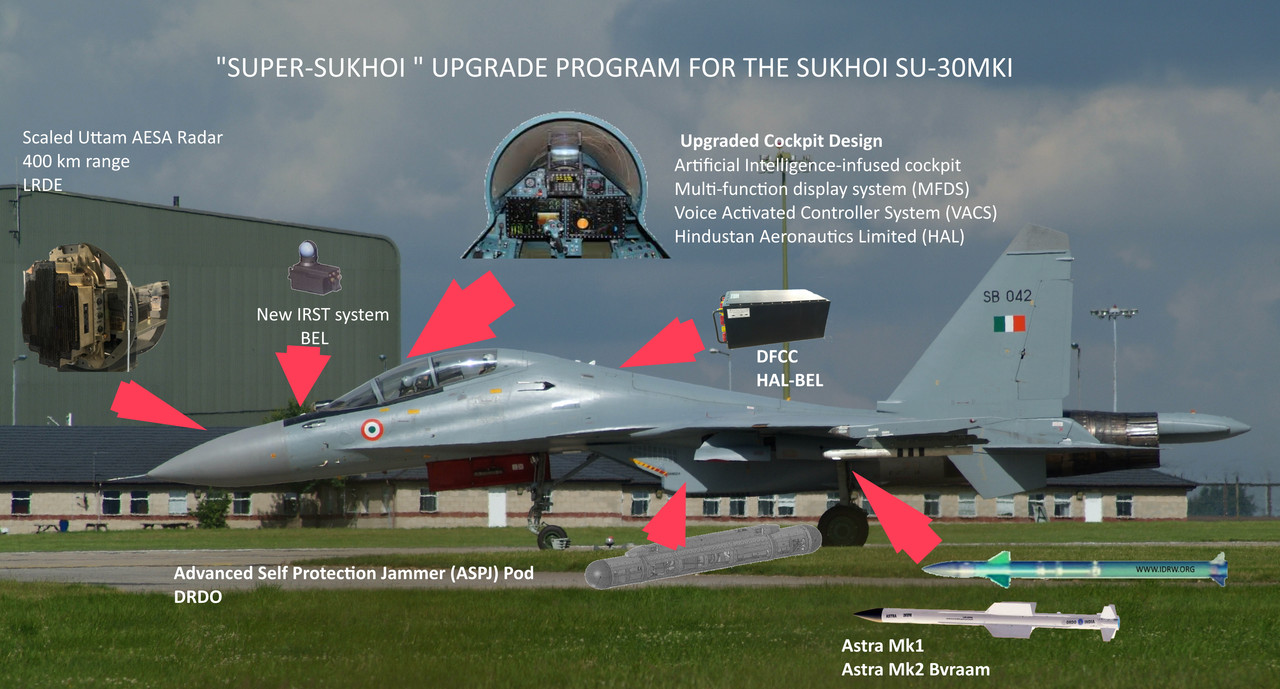SOURCE: RAUNAK KUNDE / NEWS BEAT / IDRW.ORG


India’s Ministry of Defence is progressing toward finalizing an extensive upgrade plan for 84 of its SU-30MKI fighter jets under the “Super Sukhoi” program, marking a major step in the modernization of the Indian Air Force (IAF). Following the Defense Acquisition Council’s (DAC) approval on November 30, 2023, the draft proposal for the upgrade, valued at approximately ?63,000 crore, is now pending clearance by the Prime Minister-led Cabinet Committee on Security (CCS). This ambitious project aims to enhance the operational capabilities of the SU-30MKI, transforming it into a near fifth-generation platform, though it will lack certain stealth features.
Once the CCS grants approval, a formal contract will initiate the project, with the first upgraded aircraft expected to be rolled out after three and half years. The timeline for the complete development and flight testing process is projected to span seven years. This process includes integrating advanced avionics, new radar systems, enhanced electronic warfare (EW) suites, and more powerful engines. Notably, two test-bed aircraft will be modified to the Super Sukhoi configuration, providing a basis for the comprehensive testing of new systems.
The upgrade cycle for all 84 aircraft is expected to take around 15 years to complete. The slow timeline reflects the complexity and scale of the modifications, which will require extensive design, testing, and certification before being approved for operational service.
The Super Sukhoi upgrade is anticipated to bring the SU-30MKI close to fifth-generation fighter standards, offering several critical advancements:
New Cockpit and Avionics: The cockpit is expected to be modernized with advanced avionics and multifunction displays, improving pilot situational awareness and reducing workload. The inclusion of helmet-mounted displays will also enable pilots to engage targets with ease and accuracy.
Advanced Radar and Avionics: The upgrade will include an Virupaksha Active Electronically Scanned Array (AESA) radar, vastly improving detection range, accuracy, and electronic warfare capabilities. The new radar system will provide enhanced situational awareness, target tracking, and multi-target engagement capabilities.
Enhanced Electronic Warfare Suite: The upgraded aircraft will feature an advanced electronic warfare suite, capable of countering modern threats and operating in highly contested airspace. This includes improved jamming capabilities and defensive countermeasures.
Powerful Engines: The Super Sukhoi will likely be powered by the same AL-31F engines, which is already used in the Su-30MKI fighter. However, these engines are expected to get minor upgrades from HAL that will improve thrust and fuel efficiency, allowing for higher performance and longer operational ranges.
Network-Centric Capabilities: The upgrade will integrate advanced network-centric warfare systems, allowing the SU-30MKI to operate as part of an integrated battle network. This would enable real-time data sharing with other aircraft, ground stations, and naval assets, enhancing the IAF’s situational awareness and responsiveness.
Upgraded Weapon Systems: The Super Sukhoi configuration will support a broader range of weapons, including advanced air-to-air missiles, precision-guided munitions, and potentially hypersonic missiles. This would enhance the SU-30MKI’s versatility across various mission profiles.
The Super Sukhoi upgrade is aimed at transforming the SU-30MKI into a formidable, multi-role platform capable of operating in high-threat environments. Once upgraded, these aircraft will form a critical component of the IAF’s strike capability, alongside other advanced platforms such as the Rafale and future indigenous stealth fighters.
While the upgraded SU-30MKI will not feature full stealth capabilities, it will incorporate radar-absorbing materials (RAM) and possibly structural modifications to reduce its radar cross-section, thereby enhancing survivability against modern air defense systems.
The ?63,000 crore budget allocated for the Super Sukhoi upgrade covers the costs for design, development, and testing. The project will be carried out in partnership with Russia, which has been a long-term collaborator in India’s defense industry. Additionally, HAL will play a central role in executing the upgrades domestically, contributing to the Make in India initiative and reinforcing India’s defense manufacturing capabilities.
NOTE : Article cannot be reproduced without written permission of idrw.org in any form even for YouTube Videos to avoid Copy right strikes. Websites doing illegal reproductions will get DMCA and Legal Notices.